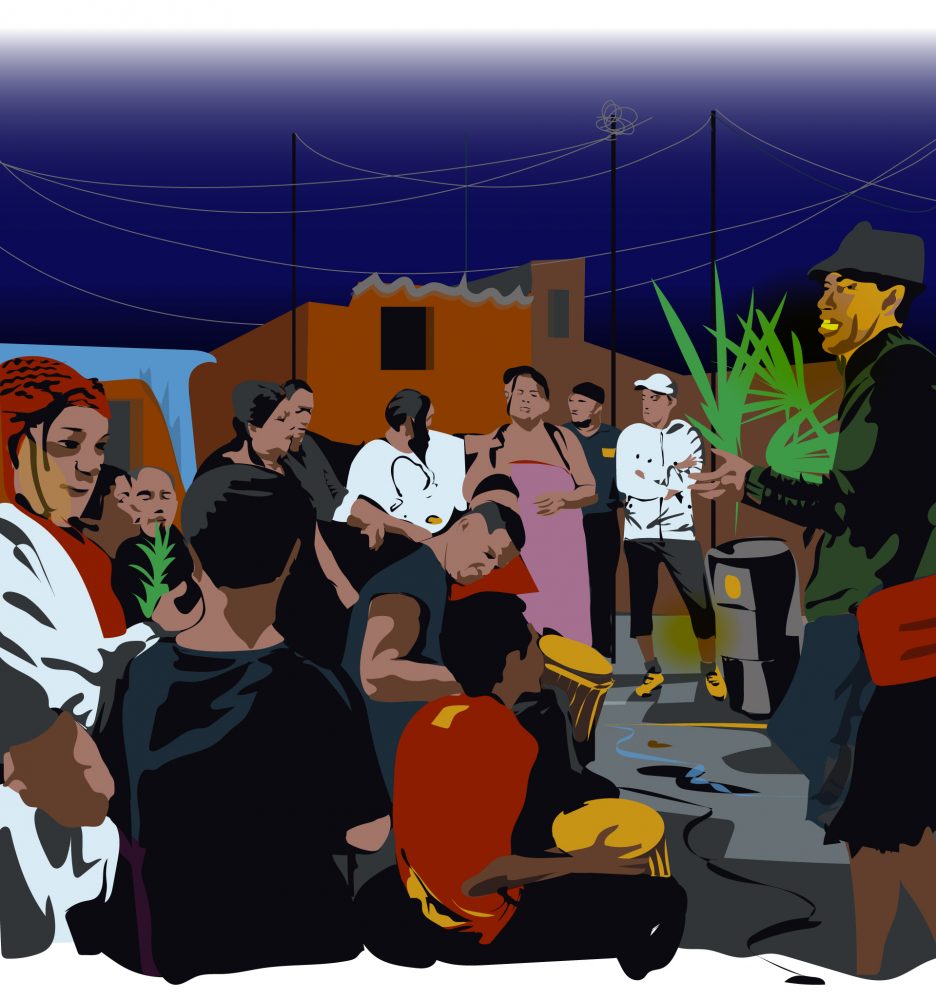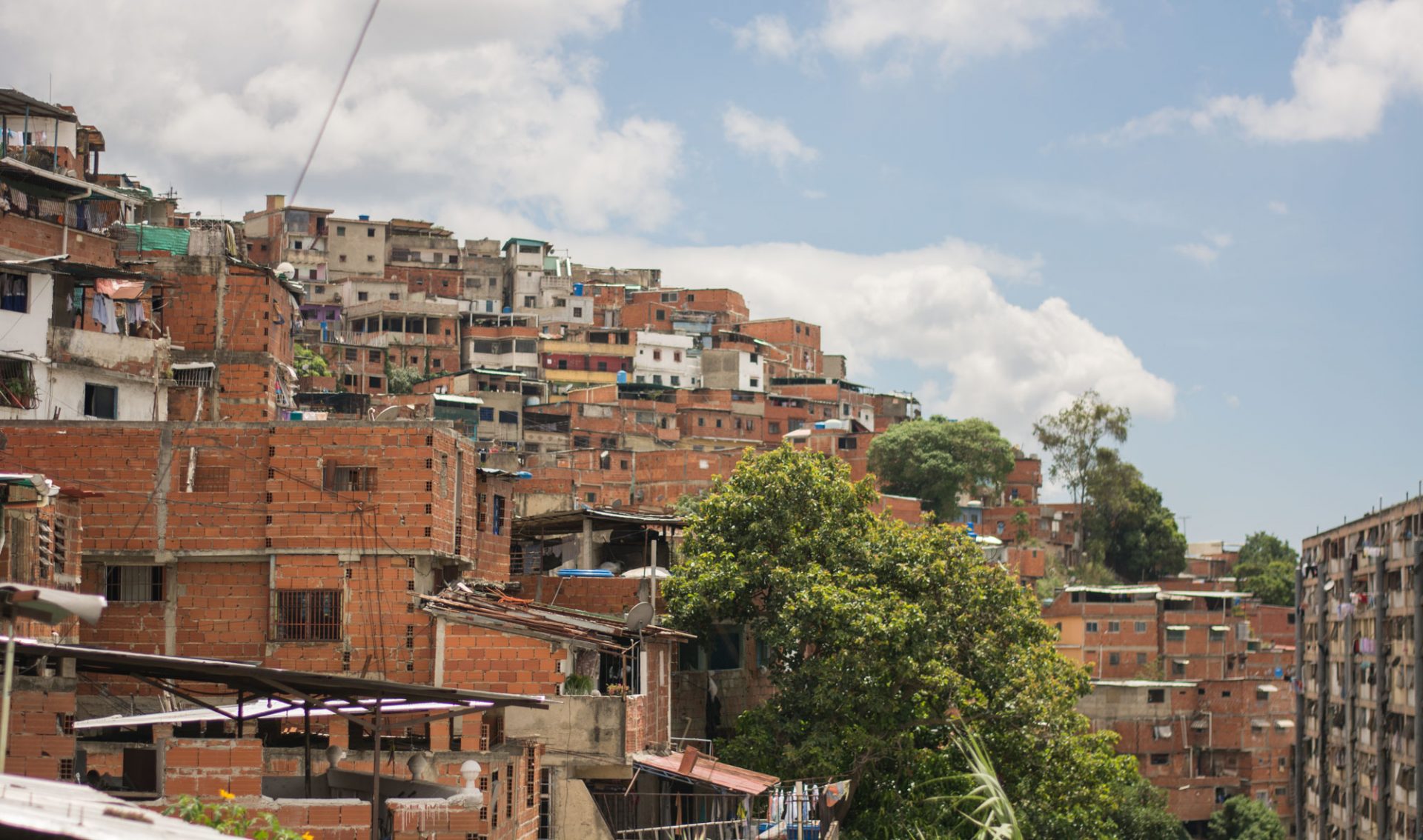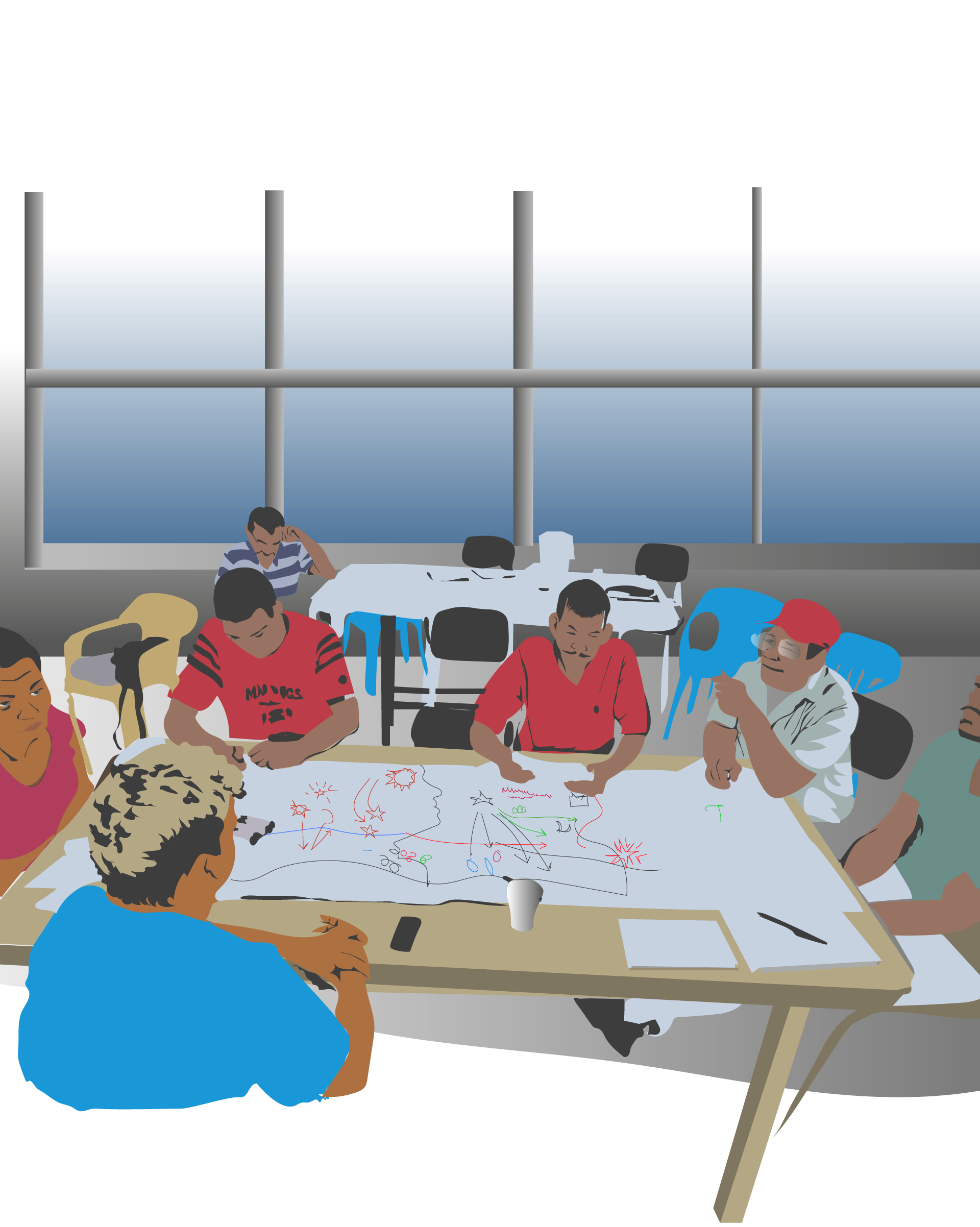Interview with Yoletty Bracho, conducted by Mathilde Allain
The Bolivarian Revolution launched by Hugo Chávez in 1999 aimed to transform the Venezuelan state. You studied its effects in the barrios (working-class districts), along with the changes in the relationship between their inhabitants and public administration. How has this “people’s power” materialized in Venezuela, and what does it mean to “transform the state” in this context?
The concept of “people’s power” is rooted in activism, but in the Venezuelan context it also has an administrative meaning. It has been used by Chavista governments (from 1999 to the present day) to label their participatory public action programs. Originally, these programs aimed to bring the Bolivarian Revolution into lower-class districts by providing people with access to public goods and services, including water, power, street-cleaning, education, and healthcare. They were based on processes labelled as participatory and cooperative that allowed beneficiaries and administrations to interact.
In order to roll out these programs, administrations employed intermediaries tasked with coordinating between public institutions and inhabitants of working-class districts. More precisely, they hired activists affiliated with left-wing political movements and organizations and who already had close political and social ties with working-class districts. These activists worked for the state out of political conviction, but also because they found employment opportunities within Chavista administrations. Their goal was twofold: to ensure that public resources reached lower-income districts, and to lay the groundwork for the maintenance of these networks long after they had gone. This is what they called transforming the state from the inside. In the end, those intermediaries can be said to have met with little success in achieving this transformation.
You mention several movements within the Venezuelan left, a divergence that somewhat contradicts the idea of a left united behind the Bolivarian Revolution. What are the different facets of the Venezuelan left?
The image of a monolithic Venezuelan left was largely created by Chavista political forces. Broadly speaking, we can identify two major groups within the Venezuelan left: the political left and the non-governmental left.
By political left, I mean groups that are affiliated with political parties. In this regard, one must keep in mind the formative role played by Hugo Chávez in the creation of the United Socialist Party of Venezuela (PSUV) in 2006 and of the “Great Patriotic Pole” (GPP – former Patriotic Pole) in 2012. These entities were founded to unify left-wing parties by merging several political organizations into a single party (PSUV), and by establishing an electoral coalition (GPP) to support PSUV candidates. Chavista forces thus aimed to rally left-wing groups behind a united electoral front while simultaneously stifling plurality within those groups and heading off political dissent.
As for the non-governmental left, it is comprised of structures known in Venezuela as “popular organizations.” Historically, these organizations joined other left-wing groups to campaign for issues such as human rights, the right to housing, and the abolition of forced military conscription. They later became the primary liaisons for Chavista governments in the implementation of participatory public action programs. For example, when community health centers were opened in a number of low-income districts in Caracas (Misión Barrio Adentro), representatives of popular organizations acted as intermediaries for public administrations, and in the process established strong ties between their organizations and Chavista governments. These ties explain why the autonomy of the popular organizations – many of which claim to be “Chavistas” – has been strictly limited, although a few of them have openly distanced themselves from certain prominent Chavista figures.
You have conducted fieldwork in Venezuela as part of your research. Can you describe the district you studied and the ways in which the people you interviewed experienced the process of state transformation?
My research mainly focused on two working-class districts in Caracas, 23 de enero (“January 23rd”) and La Vega. La Vega is a large district west of Caracas, built on a hill, like many of the city’s other low-income areas. There, I conducted my investigation in the neighborhood of Las Casitas (“Little Houses”), located high up on the hill, 15km from the historic city center. This was the home of a family whom I will refer to as the Maldonados for the purposes of this paper. They led the protests for access to housing and public services in the district during the 1970s-1980s.
Over the course of these protests, the Maldonados learned how to petition and engage with public authorities; they were then able to use that experience when Chavista governments came to power. Thus, in the 2000s, the Maldonados became the primary liaison for public administrations in the implementation of participatory public action programs in Las Casitas. Thanks to their efforts, a free-access computer center was set up in the neighborhood, along with a supermarket for subsidized goods, while the local playground was brought up to standard and made suitable for youth activities.

This example demonstrates how public resources were allocated to lower-class districts thanks to the working relationship between intermediaries like the Maldonado family, who represented the interests of their district, and the administrations themselves, which now employ activists with deep local knowledge. But we must remember that these examples are limited to a specific time and place, and that the participatory policies rolled out by Chavista governments therefore have not sustainably altered the structural inequalities that cause hardship for the country’s working class.
Have those new interactions between citizens and administrations redefined the attitude of working-class district residents toward the city, and more broadly toward politics since the 2000s?
The history of Venezuelan working-class districts is a tug-of-war between alliance and confrontation with the state. In the 2000s, the implementation of participatory policies by Chavista governments seemed, on the surface, to change things, turning the state into a potential ally. One of the most visible manifestations of these changes was the newfound access of the working class to the city. Indeed, when the daily lives of the working class were no longer limited by their economic and social ties to low-income districts, but expanded to reach the dominant political and economic interactions in the city, those segments of the population were able to forge new alliances that translated into symbolic and material goods for working-class districts.

As of late 2021, the continued tension between the working class and the state appears to be heading toward complete rupture. In this context, the mobility of the working class has been severely eroded, especially as a result of the economic and political crisis. This lack of mobility limits the local economies and social scope of the districts. Combined with the repression of dissent, these constraints have seriously hampered the ability of the working class to organize and protest.
You also studied the experience of social activists who worked for public administrations in Venezuela, focusing on changes in their means of activism, and on the change they in turn effected in the state. Who are the people who drive the revolution from within the institutions?
In my research, I identified several categories of activists who became intermediaries for participatory public action. The first category consists of activists from working-class districts. Whether through local activism or higher education, these people were able to move up the social ladder and join activist organizations outside of their districts, with a national scope. The second category is comprised of middle-class intellectuals who join working-class organizations despite having no direct ties to lower-income districts. Instead, they follow in the political footsteps of their parents (former Latin-American and Venezuelan left-wing activists), and often get their start in student organizations.
The last category is that of internationalist activists, with young people coming from various European (France, Spain) and Latin American countries (mainly Argentina) to support the Bolivarian Revolution. These three categories worked together to design and implement participatory programs launched by Chavista governments, while enduring difficult working conditions themselves. Indeed, even though those intermediaries had significant political responsibility, they were employed on upredictable short-term contracts, which necessarily limited their ability to create actual change within the state.
Efforts toward state transformation may still be plagued by major administrative, economic and political constraints, but what about public participation?
Although Chavista governments did not invent participatory policies, they did give them new impetus in the 2000s. What is left of these policies is a repertory of state action that has been recognized by political actors from a wide range of backgrounds, which leads me to believe that participatory policies will continue to exist in Venezuela in the long-term. However, their substance and meaning are likely to change. The idea of transforming the state from the inside, which enjoyed some support at the beginning of the 21st century, gave Chavista participatory policies a powerful, “popular” political meaning that strove for a measure of universality. This idea was considerably less prominent, however, in public action programs in the late 2000s and early 2010s. More recently, the participation promoted by Nicolás Maduro uses the crisis as a pretext to sidestep any political or democratic issues. It is now limited to the distribution of meager food rations to those in need.
In the current context, it is the NGOs that are taking on a central role in solidarity systems, and in the expression of human rights demands from the working class. International NGOs now rely on their Venezuelan counterparts in their day-to-day management of the crisis from a humanitarian perspective. This reorganization of solidarity policies has created a twofold rift: the political rift between civil associations and popular organizations vying to establish relations with national and international NGOs; and the social divide between activists familiar with the workings of NGOs and those who are left out.
In short, humanitarian action is now a structural feature of daily life in Venezuela. But forms of solidarity based on humanitarian action can discourage people from political engagement. Indeed, the neutrality that defines humanitarian action and that is supposed to allow aid workers to carry out their missions in deeply divided societies may distance beneficiaries from political debates, even though those beneficiaries are also citizens and therefore must play the key role in the development of a potential democratic future for their country.
One last question about the social science practices and methodology in politically polarized settings: How did you manage to conduct your field study in the deeply polarized context of Venezuelan society? How do you ensure the continuity of your work, given that the country’s political and social situation continues to deteriorate as you write?
I have had to establish a certain distance between the field studies I conducted in 2014-2015 and current events in 2021. My writing is based on data from a specific time that has meaning at a precise moment. This data sheds light on the present, but cannot explain all of the current circumstances. The analytical distance between my field studies and the current situation in Venezuela is particularly salient as I draft my dissertation; I am now writing in the past tense, although I started in the present. I know that I am dealing with dynamics that in part belong to the past, and I must treat them as such.
As for my position, as a researcher, towards my subject and field of study in the current context, I continue to feel a personal involvement in what is happening in Venezuela, and to base my work on an ethnographic method that brings me into close proximity with people on the ground. This closeness allows me to maintain my sensibility and connection to the field without jeopardizing the physical, emotional, and temporal distance necessary for objectivity. However, my own evolving political and scientific beliefs have on occasion brought me into conflict with interviewees with whom I used to be very close. Our political trajectories may drive a wedge between us, as we have different opinions about what is happening in Venezuela. Although this realization troubles me, I believe that it is through the clarity of my political and scientific convictions that I can position myself today in the Venezuelan debate, especially given the drastic changes in the country’s situation.
In this context, the binary approach that had previously dominated the political and scientific debate on Venezuela, one to which many of us might have contributed, now seems to me more meaningless than ever. The divisions through which we analyze the country should be reconsidered in order to incorporate the new dynamics underlying the lives of Venezuelans: new social and political boundaries created by migration, new manifestations of class divisions within a deeply impoverished society, and the production, reception and rejection of state violence, among others. Personally, as a researcher and an immigrant, I feel it is important to reflect on these phenomena, and on the new political and scientific demands that allow us to transcend the limits of a binary and reductive analysis of the experience of the Venezuelan people, and thus of my own experience as well.

